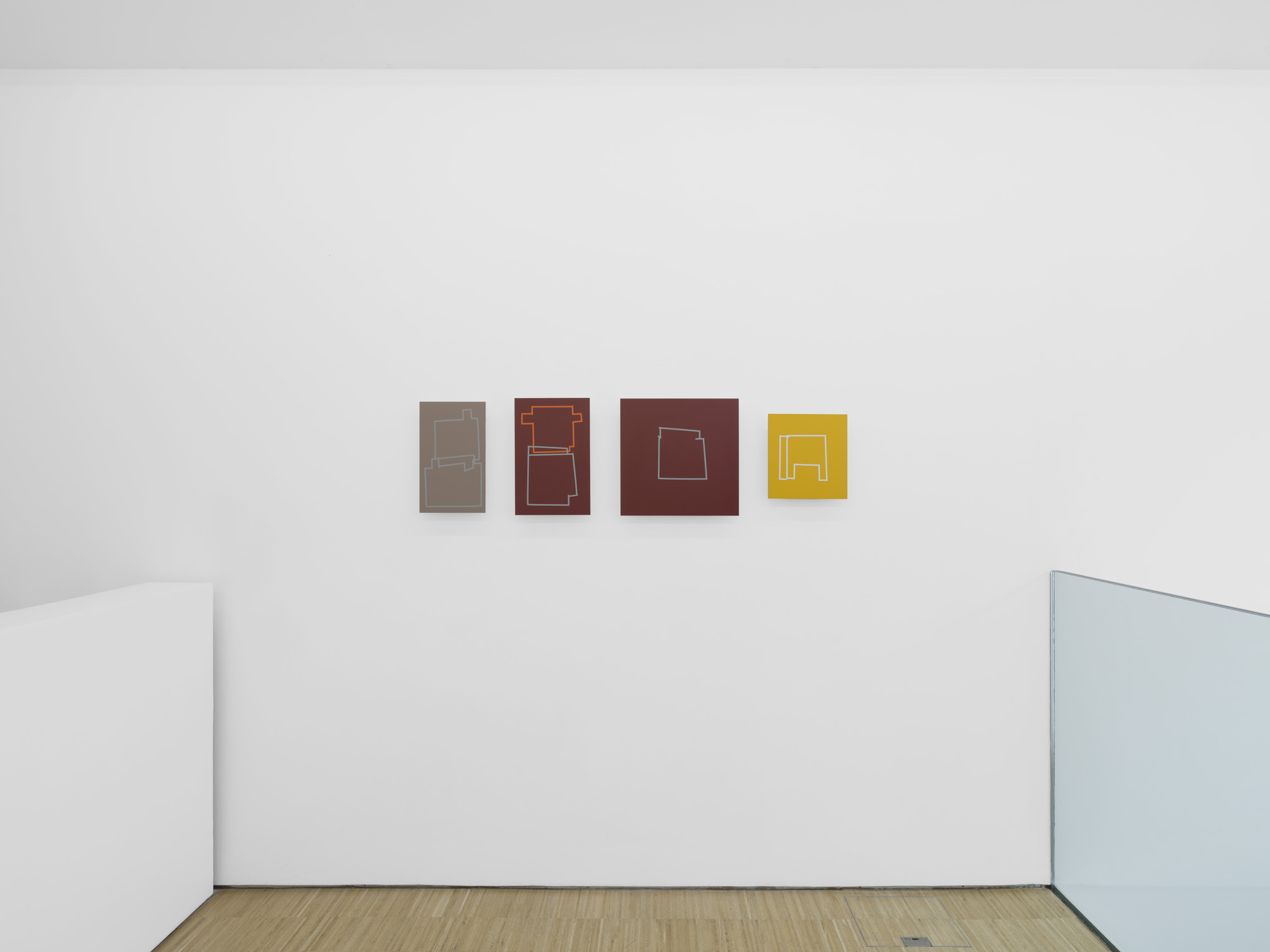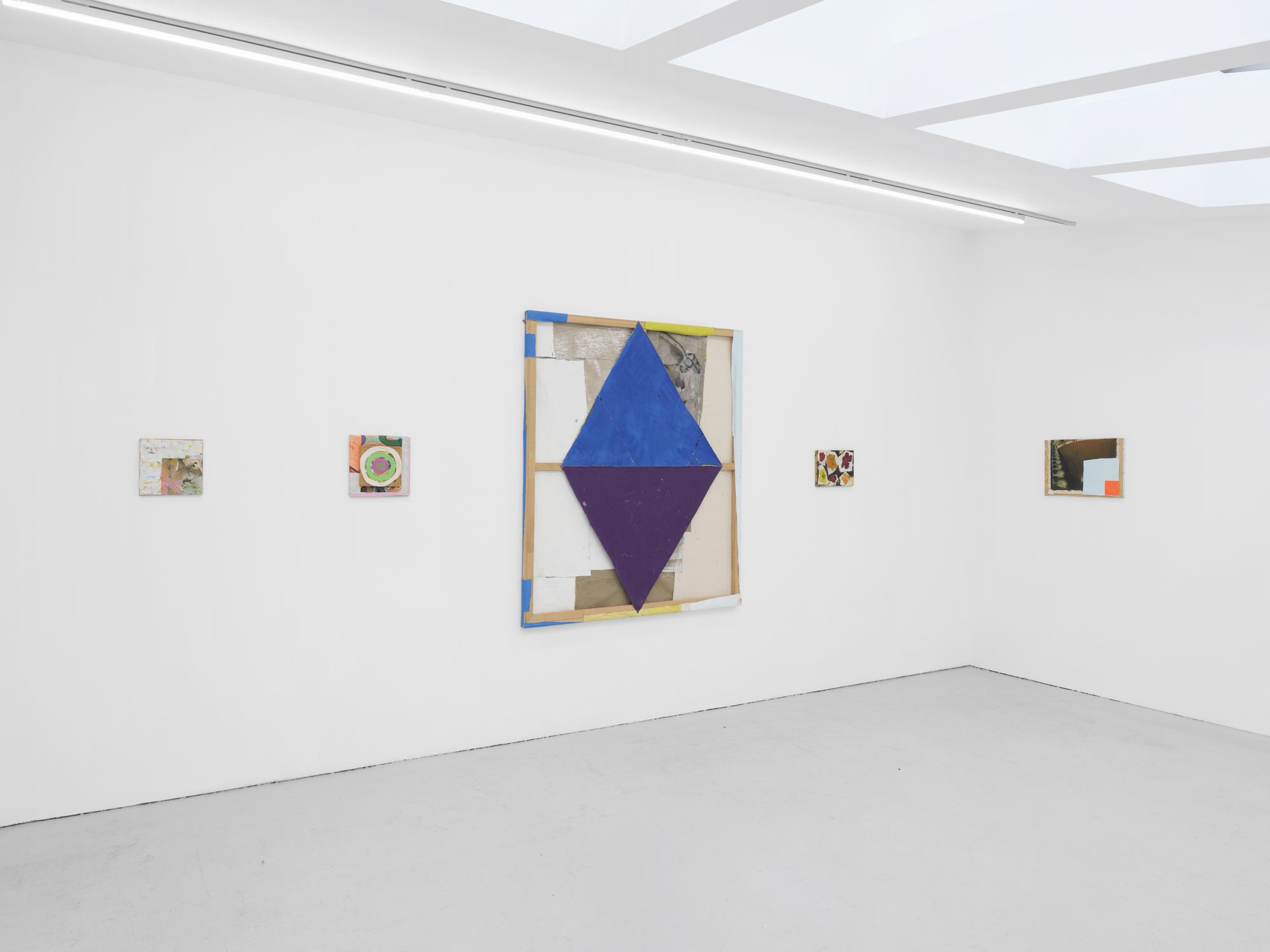Emma Adler, Bobby Dowler, Sylvie Hayes-Wallace, Ali Glover, Dux Pacifico, Anne Tallentire and Charlotte Thrane
23 February - 23 March 2024
Cob Gallery, London




Examining object biography, material manipulation and the process of building meaning, Construct is an exhibition exploring the very essence of its definition. The term construct defines the act of building or uniting materials to formulate a second structure, a second meaning. Through the lens of various materials and methods of assemblage, this exhibition examines the purpose of construction as a means of communication.
+
The new series of works by Anne Tallentire offers an intricate profiling into the outline of a found object. At first glance, the works look reminiscent of a floor plan, a subject of interest to Tallentire’s extensive practice. Here lines of vinyl tape continue her investigation into materiality and the space that exists around an object: in this case, a small broken-off corner of a pallet found on a London street. Often associated with makeshift dwellings and the transportation of goods, in this context, this fragment is used as a source material for a new depiction of space - the outer edges. Engaging with the potential of our urban surroundings and architectural detritus, Tallentire asks us to reconsider our immediate environment, the objects that populate our streets and their ability to produce new meaning. Tallentire’s works on paper speak to a similar visual language. However, these works, zoom into the domestic space, specifically her own home. Overlaying the floorplan with cropped paragraph-sized cards taken from specific passages of text referencing her reading material at the time, the experience of her building is reimagined. Made during the pandemic, these works interrogate the space within which we find ourselves confined, and where we let our thoughts linger.
+
Bobby Dowler’s work is one with multiple surfaces. Working with offcuts from his artist friends, associates, or even strangers that have been accumulated over many years. In these works, Dowler analyses, dissects and removes the subject from their original narrative to form a new visual object, one reinvented to suit the artists' desires. Dowler’s work is methodical, it engages with various modes of making whilst resisting a prescribed notion of ‘painting’ or even ‘sculpture’, which can be seen in his systematic naming of them such as Painting-Object_01(c05-17). Hanging somewhere in between these known entities, his work is a playful investigation into surface, subject and the process of construction. Endowed with their hidden narrative, each original painting - either gifted, donated or purchased by Dowler - becomes a source of inspiration, a catalyst in which new meaning can be explored to comical effect. Whilst experimenting with the painted surfaces, Dowler searches for potential subject matter to stimulate creative action, often with physical gestures of stapling, glueing, cutting, and tearing. Incorporating all the properties of his subject material Dowler strips them down to their raw materiality, where they remain ready and waiting until the artist is prepared to build a new narrative, and above all, a new object.
+
The work of Emma Adler pays homage to art history, dualism and concepts of authenticity. Working with pre-existing objects, Adler removes assigned notions of the object's biography by reimagining form and methods of replication. In her Softshell sculptures, mundane objects of domesticity are paired in a new configuration, symmetrically balanced and otherworldly - where form is recognised but altered. There are certain methods which Adler follows to achieve these subtle interventions, like colour-matching the original sink. Often sink surfaces are left raw and unpainted and through a process of imitation, Adler colour matches to the original pigment to wrap the whole entity of its form. By removing these known associations Adler questions the artificial, originality, and themes surrounding reality.
+
Central to Charlotte Thrane’s practice is material exploration. Engaging physically with our perception of space, large mattresses and soft bedding materials stack on top of one another to create a new iteration of Big Body, an installation which she previously exhibited in Århus, Miami and Frankfurt. The simple act of stacking provides a striking visual language to the viewer. The aesthetics of these stacked mattresses which depict coffee marks, yellowing stains and minor discrepancies in the fabric are purposefully imitated by the artist to question the construction of narratives. Playing with history - these marks, although artificial - explore the manipulation of time, penning new stories around these objects, to allow questions of their origin to arise. Juxtaposing these soft materials, Thrane creates a tension between their material properties and the site in which they are installed. Working within the physical space of the gallery, Thrane pushes, squeezes, and crams malleable materials into the solid structure, to create an illusion of uncertainty, one located amongst feelings of comfort and discomfort. Grappling in this tension, Big Body explores the stories embedded within the ordinary object and offers a sensitive reimagining of space and the materials we seek to comfort our bodies.
+
Measuring the size of the artist's head, Sylvie Hayes-Wallace’s, Cage Head series encapsulates the physical presence of her immediate environment and the miscellaneous ephemera that gets stuck in her head. Health insurance forms, junk mail, notes to self and receipts are some of the few materials used in the construction of Cage (Head) #1, whilst Cage (Head) #2 or Love consists of fencing wire, linen thread and floss. Assembled from mediums of varying nature, these works document a moment in time and become a portrait of the artist’s interiority, one that precariously begins to define our existence through materials; paper collected and documents preserved. Mirroring physical and psychological surroundings, Hayes-Wallaces’ diverse practice showcases the relationship between her internal space and the external world. In her works on paper, these themes are further explored; showcasing an image of a car with an assortment of bumper stickers produced by the artist and a note to self. Delicate in their presentation, but at odds, with the forceful compression of glass, these two pieces work together to deconstruct ideas around gender and the pressures of social conformity. Multiple voices can be heard amongst the manipulation of language, personal tones interrupt one another and language becomes the material in which to interrogate the self.
+
Engaging with his direct environment, Dux Pacifico’s latest works reflect the corporate structure of the city, and question how these material components begin to infiltrate our daily movement. Contradicting our usual understanding of such objects, roller shutters, which once denoted a closed space, now operate as paintings- free-standing and colourful, removed from their natural habitat. Translated into the artist's distinct visual language; these works become poetic musings on the mundane, where urban development is transformed into artistic mediums. From subtle interventions, like the gentle draping of fabric in Metropolis, to the heavy dissection of steel in Business as Usual, Pacifico can build a space for discussion with materials often associated with a different vernacular, one heavily reliant on functionality. Through both works, Pacifico is challenging the value of the objects, throwing caution to their assigned purpose and therefore challenging the nature of their materiality. Often found wandering through his urban environment; the city is Pacifico’s main source of inspiration, echoing the method of his process, these works, although static, move through spaces.
+
The newest iteration of Ali Glover’s When the Seeping Starts (II) leaves us suspended in a state of poetic possibility. Normally concealed behind the uniform hang of a dropped ceiling, here suspension strings, cable wiring, and ceiling fixings are exposed for closer observation. Working with the properties of his chosen material, Glover highlights the fragility of infrastructure and the intricacy of its construction, both psychically and metaphorically. Laden with associations and due to their frequent visibility in public buildings, ceiling tiles carry a clinical quality, where activities of care and waiting often occur beneath. In this new installation, contemplation from below is impossible and instead flipped on its head, giving visibility to the other side - the wrong side, perhaps. Contributing to this non-sensical thread of looking up, but in this case, looking down, one ceiling tile is replaced by a black steel square, made to resemble a constellational pattern in the night sky - one which would normally be viewed from below. Challenging the purpose of these structures by re-articulating their form, Glover plays with location and liminality. To accompany this installation, an audio piece newly edited by the artist plays on a loop. Composed of sound clippings of footsteps on a pebbled shore, these sounds belong to another moment, another space. Feelings of uncertainty begin to arise in our experience of the installation; there is a precariousness that the work embodies, a feeling that can only be described as something on the brink of falling.
+
By removing objects from their natural state and transforming them, domestic materials begin to comment on social infrastructure; found detritus sparks conversation around our object-fascinated culture, and reused canvas challenges the norms of conventional fine art materials. Revelling the tension between building and breaking down personal and collective narratives, Construct displays the materials artists excavate, appropriate, manipulate and collect in order to decode the world around them.



︎ Selected Press: The ‘how’ of ‘what’: Construct at Cob, Curatorial Affairs
︎ Selected Press: A Walk Through Cob Gallery’s Construct with Curator Brooke Wilson
︎ Selected Press: Construct: Cob Gallery, émergent magazine
︎ Selected Press: Hunger’s MVP of the Week, Hunger Magazine
︎ Selected Press: A Walk Through Cob Gallery’s Construct with Curator Brooke Wilson, Sleaze Magazine
︎ Exhibition: Cob Gallery